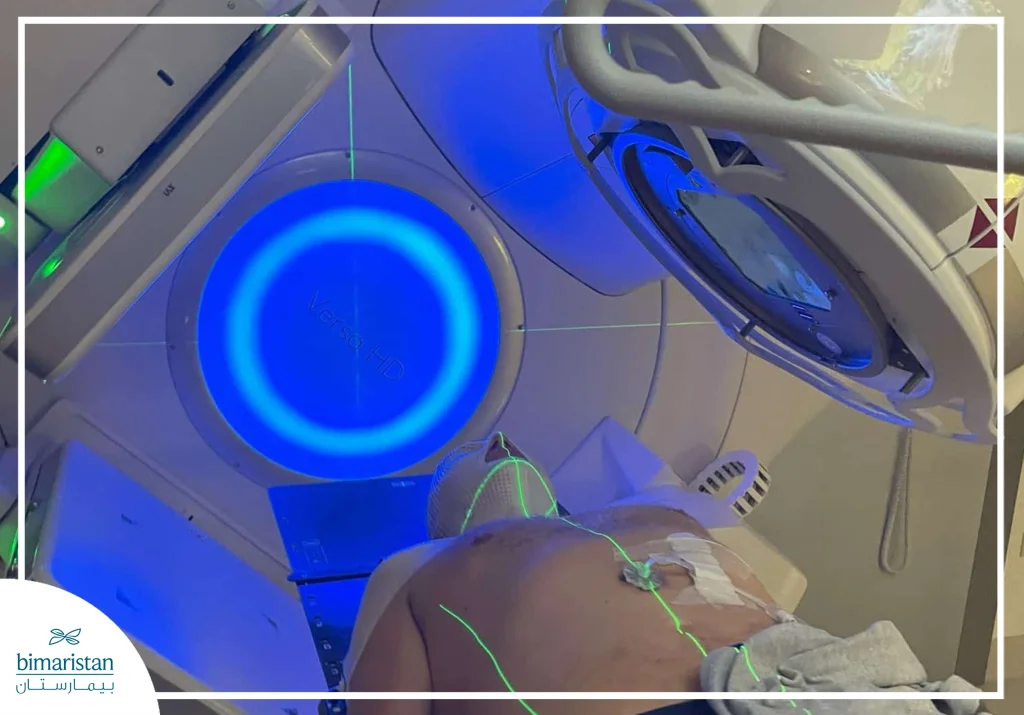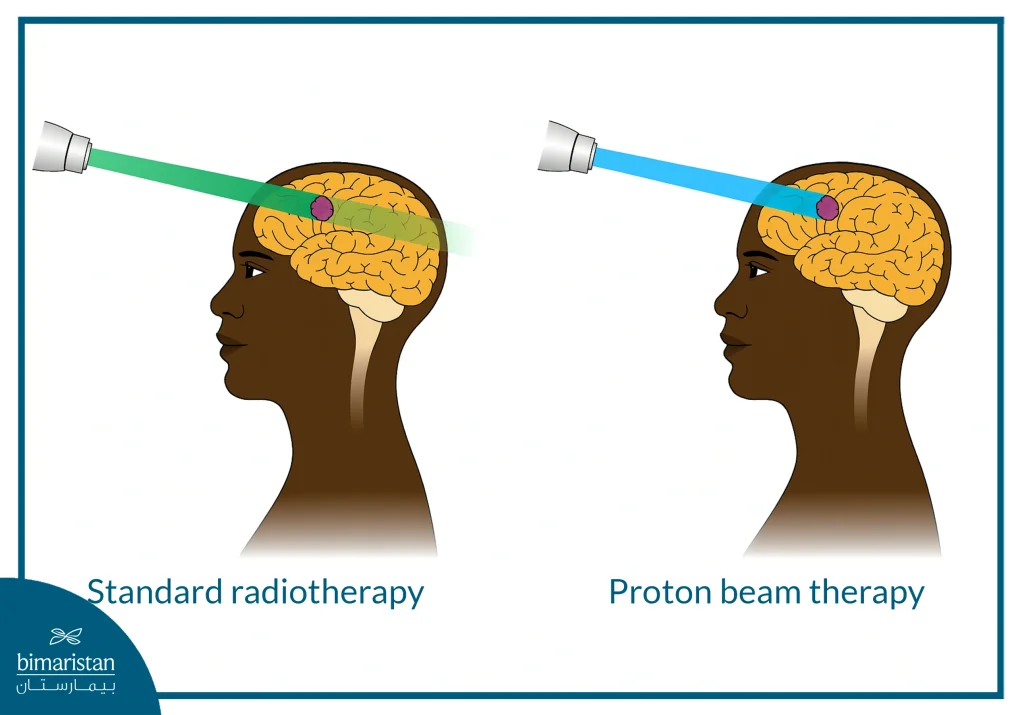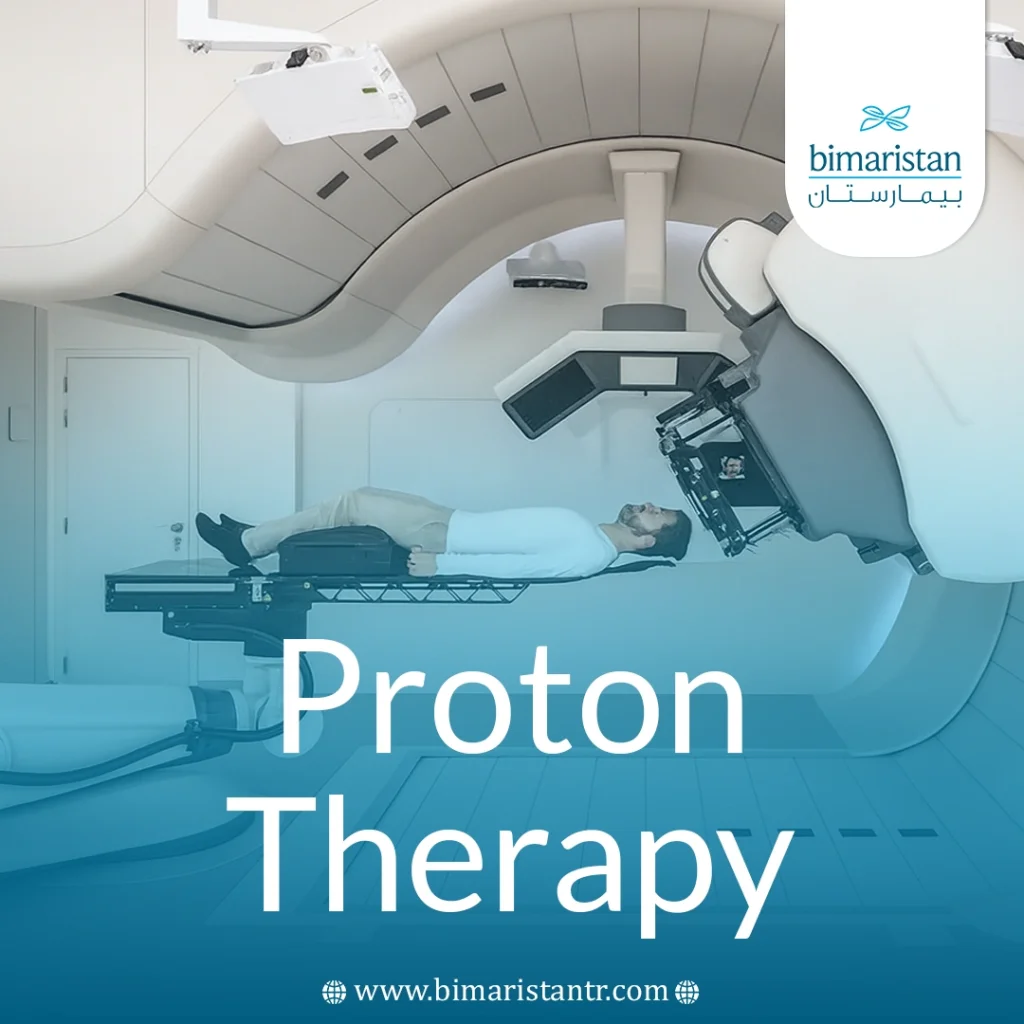The field of oncology has evolved with the emergence of new radiation techniques that aim to increase the effectiveness of treatment and minimize its side effects. Among the most prominent of these techniques is proton therapy, which, thanks to its unique physical properties, allows a high dose of radiation to be delivered directly to the tumor while protecting healthy tissue. This technique is becoming an increasingly popular option in the treatment of some of the most delicate and complex cancers.
What is proton therapy?
Proton therapy, also known as proton beam radiotherapy, is a modern form of radiation therapy that uses positively charged particles (protons) to target tumor cells with high precision.
This technique differs from traditional X-ray (photon) therapy in that the protons release most of their energy at a specific point within the tumor known as the Briggs Peak, which allows the therapeutic dose to be delivered to the tumor in a concentrated manner while minimizing the dose to surrounding healthy tissue.
This property gives proton therapy a clear advantage in reducing side effects, especially when treating tumors near sensitive organs or in children
How does proton therapy work?
Proton therapy involves accelerating small particles called protons to very high speeds, then directing them precisely towards the tumor using special accelerators such as the synchrotron or cyclotron.
When a proton enters the body, it first releases a fraction of its energy, then most of its effect is concentrated at a specific point inside the tumor known as the Briggs Peak, after which it stops advancing and does not cause additional damage to the tissues beyond the tumor. This property allows a concentrated dose of radiation to be delivered to cancer cells while protecting the surrounding healthy tissue
The beam is directed by a huge device called the Gantry that can rotate 360 degrees around the patient, and is controlled by powerful magnets that focus the beam into a thin beam that does not exceed 5 millimeters.
The energy of the protons can be adjusted so that the dose accurately reaches the desired depth, and even different doses can be distributed to different parts of the tumor, and proton radiation damages the DNA inside the cancer cells, which leads to the loss of their ability to divide and repair, and thus the tumor growth gradually stops and begins to shrink, and the effectiveness of the treatment depends on the size of the tumor, its location, and the nature of the affected cells.

Who are the candidates for proton therapy?
Proton therapy is an advanced treatment option for a wide range of tumors, whether as a monotherapy or as part of an integrated treatment plan alongside surgery or chemotherapy. It can also be used when a tumor does not respond to conventional radiation therapy or when the disease returns after a period of treatment. This type of treatment is especially used when dealing with tumors that require high precision to protect healthy tissues close to the tumor, such as:
- Head and neck cancers
- Tumors of the spine and bones
- Brain and skull base tumors
- Lung , esophageal, and breast cancers
- Eye tumors, including ocular melanoma
- Liver, pancreatic, prostate, and rectal cancers
- Lymphomas and connective tissue tumors such as sarcomas
- Cases where radiation therapy needs to be repeated after a relapse
- pediatric oncology, to reduce long-term complications from radiation
Clinical studies are ongoing to evaluate the effectiveness of proton therapy in other types of tumors, cementing its status as one of the most promising approaches to cancer treatment.
Types of Proton Therapy
Proton therapy techniques have evolved over the years to become more precise and safer, and can be divided into two main types:
- Negative scattering therapy: In this method, the proton beam is distributed using mechanical devices such as filters and masks to cover the entire volume of the tumor. It is simple and has been used since the beginning of proton therapy, but it is less able to match the exact shape of the tumor, which may result in some healthy tissue being exposed to a small amount of radiation.
- Pen Scanning Therapy: This is the newest and most advanced technique, where a very thin beam of protons is directed “like a pen” to draw the dose inside the tumor layer by layer. This technique allows the distribution of radiation with high precision that corresponds to the three-dimensional shape of the tumor, and significantly reduces the exposure of neighboring organs to harm, which is why it has become the most adopted technique in modern centers.
This evolution from conventional to pen-guided has made it possible to achieve better treatment results with fewer complications, especially in complex tumors or near sensitive organs.
What are the advantages of proton therapy?
Proton therapy is able to target the tumor with high precision, allowing a concentrated dose of radiation to be delivered to cancer cells while minimizing the exposure of surrounding healthy tissue. This feature reduces the severity of side effects compared to conventional radiation therapy and reduces the risk of developing secondary radiation-induced tumors in the long term. The advantages of this type of treatment include:
- Protecting vital neurological functions, Such as speech and memory, when treating tumors near sensitive areas of the brain.
- Repeatability of treatment: It can be safely used if the tumor returns in the same area that was previously irradiated.
- Minimize exposure to vital organs, Such as the heart and lungs, in breast or spinal cancers, minimizing long-term complications.
- is especially important in children: It minimizes the late risks associated with conventional radiation therapy, such as developmental delays or cognitive issues.
- Minimize toxicity and improve quality of life: Patients are often able to resume daily activities such as work or exercise during treatment.
- High accuracy in targeting deep tumors: With pen scanning technology that allows the dose to be precisely shaped in 3D to conform to the shape of the tumor.
- Effectiveness in tumors that are resistant to conventional radiation, Such as some bone tumors and tumors near the optic nerves or the base of the skull.
In addition, the proton beam stops working after it enters the tumor and does not leave an “exit” dose in the tissue afterward, making it safer, especially when treating tumors close to highly sensitive organs.

Preparation before proton therapy
Before treatment begins, the patient undergoes a comprehensive evaluation phase that includes a review of their medical history and imaging tests such as CT, MRI, and PET scans to pinpoint the exact location of the tumor. A special fixation mold, such as a head mask or body mold, is then made to maintain the same position for each session.
A special simulated imaging procedure known as simulated CT, a CT scan performed in the same position in which the patient will receive treatment, is used to precisely identify the tumor and protect nearby sensitive organs. Its results are often combined with other scans, such as MRI or PET, to get a clearer picture. In treatment centers, this phase is known as the simulation phase, because it simulates real treatment conditions.
The treatment team then develops an integrated radiation plan using advanced software that determines beam directions and dose distribution to the tumor while minimizing the impact on healthy tissue. This delicate process may take several weeks before treatment begins.

Proton therapy procedure steps
After the planning phase is complete, the patient begins his or her treatment sessions, which are usually conducted five times a week for several weeks, but in some special cases may be limited to one or a few sessions. The patient does not feel the radiation passing through their body during treatment, but they may hear the sounds of the machine as it is turned on. The basic steps of the session include:
- Posture stabilization: The patient is positioned on the treatment table using a customized stabilization device, such as a head mask or body mold, to maintain the same position for each session.
- Checking the position: A quick image (X-ray or CT scan) is taken to make sure the body is in the correct position as planned.
- The medical team leaves: The team exits to the control room but remains in visual and auditory contact with the patient at all times.
- Beam guidance: The Gantry, a large mechanical arm capable of rotating 360 degrees, is guided to aim the proton beam at the tumor from multiple angles depending on the treatment plan.
- Dose administration: The beam is shone for several minutes and may be turned on and off several times depending on respiratory movement or tumor position.
- Continuous follow-up: The patient undergoes periodic check-ups (usually a weekly CT scan) to make sure the doses are accurate and recalculated if the tumor size or the patient’s weight changes.
The actual treatment time is usually only a few minutes, but preparation and positioning can take 30 to 45 minutes per appointment.
What are the risks and side effects of proton therapy?
Despite the many advantages of proton therapy, it is not the best option for all patients, as it comes with certain challenges and risks that need to be considered.
Possible side effects of proton therapy
Since the treatment precisely targets the tumor, healthy tissues are less affected compared to conventional radiation, but there are some symptoms that vary depending on the location of the tumor and the dose of treatment, including:
- Skin redness or irritation
- Fatigue and general tiredness
- Hair loss in the treated area
- Localized pain or discomfort at the treatment site
Cons and challenges of proton therapy
- Limited availability: The number of proton therapy centers around the world is still small, so patients may have to travel long distances and undergo a treatment program that may last several weeks.
- Planning time: Doctors need more time to develop an accurate treatment plan than with traditional radiation therapy, which may not be appropriate in cases where treatment needs to be started quickly.
- Cost and insurance coverage: Proton therapy is more expensive due to the complex equipment and infrastructure, and in some cases, insurance companies may not agree to cover it due to the lack of conclusive evidence that it is superior to conventional radiation for all types of cancer.
How effective proton therapy is, according to studies
Studies indicate that proton therapy achieves similar or superior treatment outcomes to conventional radiation with a significant reduction in toxicity. For example, a clinical analysis showed that local tumor control rates in skull base tumors exceeded 80-90% after five years, with a significant reduction in neurological symptoms compared to photons. In pediatric tumors, reviews have shown that proton use reduced late complications by up to 40% compared to conventional therapy, including developmental and cognitive issues.
Other studies have also shown that patients who received proton therapy for head and neck tumors experienced lower rates of dry mouth and swallowing difficulties by nearly 50% compared to photon radiation. Although large randomized studies are still limited, these findings support proton therapy as an effective treatment option, especially in sensitive and complex cases. Research is currently ongoing to confirm its usefulness in common cancers such as breast and prostate.
In conclusion, proton therapy is one of the most advanced techniques in oncology, allowing for more precise targeting of the tumor while minimizing harm to healthy tissue. Studies have shown it to be particularly effective in pediatric and sensitive tumors, making it a promising option despite its current limited availability, and with continued progress, it is expected to occupy a greater place in future cancer treatment methods.
Sources:
- Liu, H., & Chang, J. Y. (2011). Proton therapy in clinical practice. Chinese journal of cancer, 30(5), 315-326. https://doi.org/10.5732/cjc.010.10529
- Bicer, B. (2023). Proton Therapy and Photon Radiation Therapy: A Clinical Review. Frontiers in Oncology, 13, 1133909. https://doi.org/10.3389/fonc.2023.1133909
- Mohan R. (2022). A Review of Proton Therapy – Current Status and Future Directions. Precision radiation oncology, 6(2), 164-176. https://doi.org/10.1002/pro6.1149
- Odei, B. C. L., Boothe, D., Keole, S. R., Vargas, C. E., Foote, R. L., Schild, S. E., & Ashman, J. B. (2017). A 20-Year Analysis of Clinical Trials Involving Proton Beam Therapy. International journal of particle therapy, 3(3), 398-406. https://doi.org/10.14338/IJPT-D-16-00030.1
- Johns Hopkins Medicine. (n.d.). Proton therapy. Johns Hopkins Medicine. https://www.hopkinsmedicine.org/health/treatment-tests-and-therapies/proton-therapy
